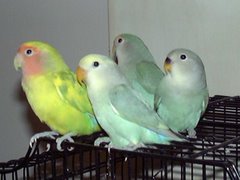Get to Know about Masked Lovebirds
The pet owners just love the lovebirds like anything. One should not get fooled by their size. Lovebirds are true parrots. As these birds are very small in size, their accommodation can be small as well; hence the expense is very much less compared to the full size parrots. Lovebirds care is utmost important for a pet bird owner
Most of the species of lovebirds are native of Africa and Madagascar. As the name suggests these birds love their partner very much and remain close to each other hours together. These love birds do fight savagely with their own species at the time of breeding. Though these birds are small, they can adjust with most climates. As these lovebirds are quiet and good breeders in captivity, these birds are ideal aviary birds. The lovebirds can not talk but are very intelligent creatures. These lovebirds can survive up to ten years and no longer than that.
The lovebirds are very popular exhibition birds. There are more numbers bird club in United States of America which is very much interested in love birds. Peach faced, Fischers and masked love birds are bred by many. The other species are generally termed as rare as they are unknown to aviary. They are nyasal love bird, Madagascar love bird, black cheeked love bird, Abyssinian love bird, red faced love birds,black collared love bird, and black masked love birds.
The head of the black masked love bird is black and plumage colour is green. The collar will be yellow in colour. The other important characteristic of this species is white ring that encircles both the eyes. In addition to traditional green, so many other colour morphs are also noted in few birds. Blue morph is the most popular in western hemisphere. The first mutation is the blue mutation that came in existence from the wild stock. Albinos, pastel blue, and cinnamon pied are the other colour mutations that are bred in United States of America. Pastel blue is a mixture of dilute green and blue.
The Black masked lovebirds are native of Africa. These love birds can also be found on the islands of north east Tanzania. These love birds are hardy species and the Australian breeders, most of them propagate these birds in colony system. The masked love birds tend to dip pieces of their nesting material in the water in order to soften them and to retain the humidity in their nest
Most of the species of lovebirds are native of Africa and Madagascar. As the name suggests these birds love their partner very much and remain close to each other hours together. These love birds do fight savagely with their own species at the time of breeding. Though these birds are small, they can adjust with most climates. As these lovebirds are quiet and good breeders in captivity, these birds are ideal aviary birds. The lovebirds can not talk but are very intelligent creatures. These lovebirds can survive up to ten years and no longer than that.
The lovebirds are very popular exhibition birds. There are more numbers bird club in United States of America which is very much interested in love birds. Peach faced, Fischers and masked love birds are bred by many. The other species are generally termed as rare as they are unknown to aviary. They are nyasal love bird, Madagascar love bird, black cheeked love bird, Abyssinian love bird, red faced love birds,black collared love bird, and black masked love birds.
The head of the black masked love bird is black and plumage colour is green. The collar will be yellow in colour. The other important characteristic of this species is white ring that encircles both the eyes. In addition to traditional green, so many other colour morphs are also noted in few birds. Blue morph is the most popular in western hemisphere. The first mutation is the blue mutation that came in existence from the wild stock. Albinos, pastel blue, and cinnamon pied are the other colour mutations that are bred in United States of America. Pastel blue is a mixture of dilute green and blue.
The Black masked lovebirds are native of Africa. These love birds can also be found on the islands of north east Tanzania. These love birds are hardy species and the Australian breeders, most of them propagate these birds in colony system. The masked love birds tend to dip pieces of their nesting material in the water in order to soften them and to retain the humidity in their nest








 Free Ads For Bloggers
Free Ads For Bloggers

